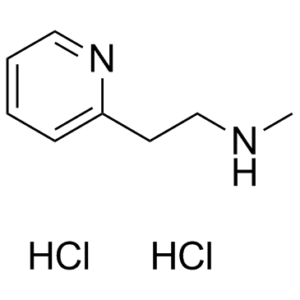This product is for research use only, not for human use. We do not sell to patients.

| Size | Price | Stock |
|---|---|---|
| 25g | $200 | Check With Us |
| 50g | $300 | Check With Us |
| 100g | $450 | Check With Us |
Cat #: V1236 CAS #: 5579-84-0 Purity ≥ 98%
Description: Betahistine dihydrochloride (formerly PT 9; PT9; trade names Veserc, Serc, Hiserk, Betaserc, Vergo), the dihydrochloride salt of Betahistine which was pproved in EU in 1970s for treating Ménière's disease, is a potent antagonist of histamine H3 receptor used as an anti-vertigo drug.
Publications Citing InvivoChem Products
Product Promise

- Physicochemical and Storage Information
- Protocol
- Related Biological Data
- Stock Solution Preparation
- Quality Control Documentation
| Molecular Weight (MW) | 209.12 |
|---|---|
| Molecular Formula | C8H12N2.2HCl |
| CAS No. | 5579-84-0 |
| Storage | -20℃ for 3 years in powder formr |
| -80℃ for 2 years in solvent | |
| Solubility In Vitro | DMSO: 38 mg/mL (181.7 mM)r |
| Water: 38 mg/mL (181.7 mM)r | |
| Ethanol: <1 mg/mL | |
| Solubility In Vivo | Chemical Name: Methyl[2-(2-pyridyl)ethyl]amine dihydrochloride SMILES Code: CNCCC1=NC=CC=C1.[H]Cl.[H]Cl |
| Synonyms | PT-9; Betahistine dihydrochloride; Betahistine HCl; PT 9; PT9; trade names Veserc, Serc, Hiserk, Betaserc, Vergo. |
| Protocol | In Vitro | Betahistine dihydrochloride (0-10 μM) inhibits [125I]iodoproxyfan binding to membranes of CHO (rH3(445)R) and CHO (hH3(445)R) cells with IC50 values of 1.9 μM and 3.3 μM, respectively. Lead to Ki values of 1.4 μM and 2.5 μM, respectively. |
|---|---|---|
| In Vivo | Betahistine dihydrochloride (intraperitoneal or oral administration; 0.1-30 mg/kg; single dose) with acute administration has increased tele-methylhistamine (t-MeHA) levels with an ED50 of 0.4 mg/kg, indicating the inverse agonism. Besides, after acute oral administration, it increases t-MeHA levels with an ED50 of 2 mg/kg in male Swissmice |
| Solvent volume to be added | Mass (the weight of a compound) | |||
|---|---|---|---|---|
| Mother liquor concentration | 1mg | 5mg | 10mg | 20mg |
| 1mM | 4.7819 mL | 23.9097 mL | 47.8194 mL | 95.6389 mL |
| 5mM | 0.9564 mL | 4.7819 mL | 9.5639 mL | 19.1278 mL |
| 10mM | 0.4782 mL | 2.3910 mL | 4.7819 mL | 9.5639 mL |
| 20mM | 0.2391 mL | 1.1955 mL | 2.3910 mL | 4.7819 mL |
This equation is commonly abbreviated as: C1 V1 = C2 V2
- (1) Please be sure that the solution is clear before the addition of next solvent. Dissolution methods like vortex, ultrasound or warming and heat may be used to aid dissolving.
- (2) Be sure to add the solvent(s) in order.




































